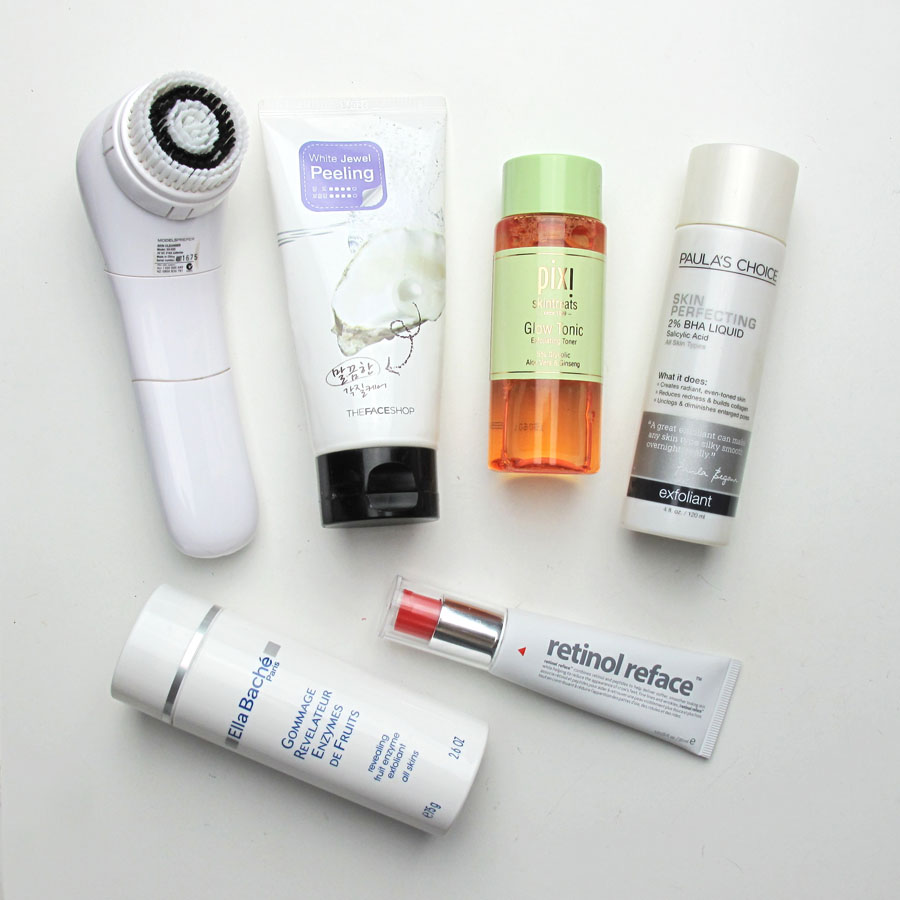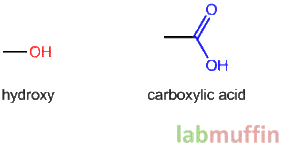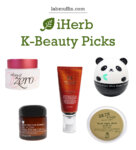Here’s the final part of this series on exfoliation. We’ve looked at all of the physical exfoliants and chemical exfoliants, now we’re turning to the most important question: Which exfoliant should you use? And how often?
Or which exfoliants, rather. Because once you start seeing the results from exfoliating – the glowy skin, the smooth texture, the pigmentation fading – you’ll want to try more. It’s a slippery slope into pretty skin. Unfortunately though, this process can be painstaking and slow, since it takes a while to see the results of any changes in your skincare routine, so have patience!
Guiding Rules
Let’s lay out some guiding principles before we get too excited…
1. Add one new product at a time, a couple of weeks apart
Introducing a whole bunch of skincare products at once is tempting, but a bit of self-control is a good idea. The key reason is that if your skin has a reaction (allergy, irritation, breakouts or just clogged pores), you won’t be able to work out what the culprit is for a while. You’ll have to take everything out, then reintroduce them one by one a couple of weeks apart to check.
Best case scenario? Your skin doesn’t react, it looks amazing, but now you don’t know which of the 5 new products worked. Your skincare routine now takes 3 hours and costs $200 a month.
2. Go slow
This applies to all dimensions of exfoliation. For everything, you need to patch test first if you have sensitive skin. If you have robust skin, you should still patch test first, but I’m the first to admit that I’m too impatient for this most of the time.
In terms of frequency, this means start off with once a week, and if your skin can handle it, then work up gradually.
In terms of harshness for physical exfoliation, start gentle – this means starting with the softest brush, or the finest grains, or pressing gently and scrubbing for only a few seconds.
For chemical exfoliation, this means starting on a lower percentage and working upwards, or starting for a few minutes if it’s a wash-off product, before working up to 10 minutes or whatever the maximum recommended time is.
3. Watch out for overexfoliation
Sensitive, red, tight, weirdly shiny (not in a good way) skin is a hallmark of exfoliating too much, too fast. Your skin needs its protective outer layer, and scrubbing too much off will lead to inflamed, dehydrated skin. If this happens to you, put a hold on all exfoliation until your skin gets back to normal – then let it rest for a few days before going back to exfoliating.
4. Your mileage may vary
This applies to skincare in general. Human skin is all the same to some extent, but it’s still different enough that no product will ever work for everyone the same way. So don’t blindly follow someone on social media who has great skin and scrubs with diamond dust for 5 hours a day – but at the same time, if there’s someone with similar skin concerns as you, and a particular product worked fantastically for them, then it could be a good starting point.
5. Don’t just exfoliate
You should be cleansing before you exfoliate, and moisturising afterwards. Your skincare needs might also change a bit as you exfoliate more regularly.
How to Get Started
Depending on your skincare routine and how well you know your skin, you may be able to skip some of these steps.
1. Stop all exfoliation you currently do in your routine
Step 1 is to stop all the exfoliation your currently do, then get set up with a barebones routine (cleanser, moisturiser, sunscreen) until your skin adjusts to its normal state (a couple of weeks).
Most people who are new to skincare tend to overexfoliate – daily apricot scrubs, Clarisonic use twice a day, etc. If this is you, you’ll need to put your exfoliation on pause to allow your skin to recover, so you can see what actually works with your skin in its healthy state.
2. Introduce a gentle exfoliant into your routine
Start with a gentle physical or chemical exfoliant, depending on what your skin’s needs are. Use it once weekly. Observe the results after a couple of weeks. If you don’t like the results or you don’t see a difference, switch to another exfoliant until you do find one you like. Then…
3. Increase exfoliation
Once you find an exfoliant that works for you, you can:
- Increase the strength of your current exfoliant: increase the percentage if it’s a chemical exfoliant, or increase the time it’s acting on your skin
- Increase the frequency of your current exfoliant: use it twice as often, for example
- Add another gentle physical or chemical exfoliant: if you want to address a problem your current exfoliant doesn’t help with, you can add a different exfoliant to your regimen to tackle that issue. Make sure you don’t use both exfoliants in the same session!
Remember: Wait at least 2 weeks before changing your routine! If it’s too much, then refer to rule #3: put a hold on the extra exfoliant, let your skin calm down, then try something else.
Eventually you’ll get to know the effect that each exfoliant has on your skin, and you can adjust the frequency or strength of the exfoliants you’re using in your routine according to what your skin needs.
Choosing an Exfoliant
Physical or Chemical?
The two major categories of exfoliant are physical exfoliants, which buff away dead cells mechanically, and chemical exfoliants, which remove dead cells by unsticking the glue holding them together, or by correcting the rate at which the skin produces skin cells.
Both types of exfoliation have their benefits, and different types of physical or chemical exfoliation have their advantages and disadvantages too. For most people, I would recommend working up to using both. There are no hard and fast rules about only using AHAs for dry skin, or only using scrubs on oily skin – all skin types can benefit from both physical and chemical exfoliants. Both can be suitable for sensitive skin, if you stick to the gentle ones.
In general, people tend to see greater effects using chemical exfoliation, as the results are longer lasting since they work on the deeper layers of the skin.
Which physical exfoliant should I use?
Here’s a quick guide to physical exfoliants, with strength ratings and the advantages and disadvantages of each method. You can find more details on usage, and a few examples of each type in the first post in this series on physical exfoliants.
A disclaimer: The strength ratings are based on subjective experience (my own and those of other skincare nerds) – there isn’t a standardised test for harshness, and even if there was, there would be a lot of variation between products in a category. Physical exfoliation strength also depends a lot on the way it’s used (for how long, with how much pressure, with what sort of motion etc.).
You should start using each physical exfoliant with light pressure, in small circles, for no longer than a minute.
| Exfoliant | Category | Strength | Notes |
|---|---|---|---|
| Peeling gel | Products | Gentle | + Gentle and thorough + Affordable Korean products available online - Uncommon in Western stores - Some products do not work well in-shower |
| Oatmeal | Products / DIY | Gentle | + Contains anti-irritant and hydrating ingredients + Cheap if DIY |
| Konjac sponge | Tools | Gentle | + Reuseable (~3 months) + Can be used with cleansers - Bacterial buildup if not thoroughly dried and washed - Difficult to dry |
| Cleansing cloth | Tools | Gentle to medium | + Range of roughnesses available, from soft cotton cloths to microfibre towels to rougher Salux nylon cloths + Reuseable (3-12 months) + Can be used with cleansers - Bacterial buildup if not thoroughly dried and washed - Can be difficult to dry |
| Sponge | Tools | Gentle to medium | + Range of roughnesses available + Reuseable (3-12 months) + Can be used with cleansers - Bacterial buildup if not thoroughly dried and washed - Can be difficult to dry |
| Plastic microbeads | Products | Gentle to medium | + Regularly sized and smooth - Damages environment - Being phased out in many countries |
| Jojoba beads | Products | Gentle to medium | + Regularly sized and smooth + Found in many products |
| Crushed nuts (soaked) | Products / DIY | Gentle to medium | ± Must be soaked to be softer |
| Silk cocoon | Tools | Gentle to medium | - Relatively expensive - Difficult to wash |
| Salt and sugar grains | Products / DIY | Gentle to strong | + Dissolve in water so wash away easily + Can be added to any cleanser for a DIY scrub + Range of grain sizes easily available + Cheap if DIY - Larger grains can be rough on skin |
| Bamboo beads | Products | Medium | |
| Alumina | Products | Medium | |
| Coffee grounds | Products / DIY | Medium | + Cheap if DIY - Messy and leaves brown streaks |
| Baking soda | Products / DIY | Medium | + Cheap if DIY - High pH |
| Pumice | Products | Medium to strong | ± Strength depends on grain size |
| Face brush | Tools | Medium to strong | + Reuseable + Can be used with cleansers + Comes in vibrating, oscillating and manual forms - Bacterial buildup possible if not thoroughly dried and washed - Easy to overuse (some instructions encourage overly frequent use) |
| Sand | Products / DIY | Medium to strong | - Difficult to acquire evenly sized, clean sand |
| Apricot kernel | Products | Strong | + Found in many products - Rough on skin |
| Dermaplane | Tools | Strong | + Highly effective - Requires practice to perform safely on yourself - Costly if performed regularly by a professional |
| Microdermabrasion | Tools | Strong | + Highly effective - Expensive - Requires a professional |
Which chemical exfoliant should I use?
Chemical exfoliants are a bit harder to order because there’s a lot of variations in formulation and additional considerations that can drastically change the amount of exfoliation possible. Keep this in mind when choosing a product – with each category, start with a low percentage and/or short application time (where applicable). If your skin is particularly sensitive, you can start by washing off a leave-on product after a few hours, even if the instructions advise you not to rinse. If you experience stinging initially with a leave-on product, you can mix it with a moisturiser first, until you get used to it.
| Exfoliant | Advantages | Disadvantages | Notes |
|---|---|---|---|
| Leave-on glycolic acid | + most potent of the HAs + humectancy adds moisture + acts on hyperpigmentation and wrinkles | - increases sun sensitivity - most likely to cause side effects like PIH, especially in darker skin - most scientific evidence available | * Start with pH
* Use a good sunscreen daily during and for at least a week after use * Recommended for dry ageing skin |
| Leave-on lactic acid | + less side effects and irritation + humectancy adds moisture + acts on hyperpigmentation and wrinkles | - more difficult to find | * Start with pH
* Use a good sunscreen daily during and for at least a week after use * Recommended for dry ageing skin |
| Leave-on salicylic acid | + theoretically better for oily skin and clogged pores + acts on hyperpigmentation and wrinkles + can treat blackheads and reduce pores + UV protective while on skin + anti-inflammatory | - can be drying | * Start with pH
* Use a good sunscreen daily during and for at least a week after use * Recommended for oily acne-prone skin * Patch test if you're allergic to aspirin |
| Leave-on poly hydroxy acid | + less irritating + can increase collagen + acts on hyperpigmentation and wrinkles + doesn't increase sun sensitivity | - not much scientific evidence - expensive and rarer | * Includes lactobionic acid and gluconolactone * Use a good sunscreen daily during and for at least a week after use |
| Other leave-on acids | + less side effects and irritation + acts on hyperpigmentation and wrinkles | - not much scientific evidence - expensive and rarer | * Includes malic, mandelic and citric * Use a good sunscreen daily during and for at least a week after use |
| At-home peels | + can improve more severe acne, pigmentation and wrinkles than lower %s + no downtime | - can be painful - involves corrosive chemicals that can cause scars if not used carefully | * Use a good sunscreen for at least a week after use * Use the matching leave-on HA regularly before switching to the peel |
| Medium and deep peels | + can improve deep acne, pigmentation and wrinkles | - can be painful - requires recovery time - can cause scarring if improperly performed or cared for afterwards | * Don't self-administer these without training |
| Retinol | + available without a prescription + antioxidant and collagen-preserving effects | - increases sun sensitivity - dries out skin - inactivated by light | |
| Retinoids | + antioxidant and collagen-preserving effects + stronger effects than retinol | - require a prescription - increases sun sensitivity - dries out skin - inactivated by light | |
| Enzymes | + can be made using DIY + theoretically low irritation + not pH dependent | - very little scientific evidence - found in fruit which can cause allergies in some people | * Wash-off only |
My Exfoliation Routine
Here’s what my current exfoliation routine looks like. I’ve built it slowly over the past 5-ish years of nerdery, so I know my skin pretty well and adjust it according to what my skin’s needs are (it changes depending on the season, the stage in my menstrual cycle, the amount of sleep I’ve had, the way the wind’s blowing…).
Physical exfoliation: once a week. I use either a vibrating, non-oscillating cleansing brush (medium strength) with a cleanser for about 1 minute on my face, or a peeling gel (gentle strength) for about 1 minute on my face.
Chemical exfoliation: twice a week. Depending on my skin’s needs, I use:
- AHA or retinol on my cheeks
- Salicylic acid on my T-zone
- Enzyme exfoliant all over (wash-off)
Approximately once every two months I do a peel as well.
That’s all the planned parts I have – do you have any additional questions? Please let me know!







I’ve loved this series Michelle – Exfoliation is one of my favourite skincare steps (is that weird!?) so I’ve found it so interesting to learn more! Thank you for sharing 🙂
Jess xo
Your posts are always so well researched and informative, including this one. Thanks so much!
Thanks so much for your informative posts. I wondered what your take is on the idea that your skin can “get used to” retinoids. Is that true?
I just discovered your blog and am loving all of the information! Keep up the great work!
This is a great read!
So informative.
I alternate between using Pixi and P50.
I was using one or the other twice a day, however it was too much, I now use one or the other every few days.
Such an informative post! Keep more coming 🙂
Thank you! 🙂
Hi Michelle,
Just discovered your website. I basically ran in the kitchen to get a lemon muffin along with a cup of hot tea, sat down comfortably with a blanket and started reading your reviews. Brilliant, very informative: I like your “let’s cut to the chase” style. I especially enjoyed your reviews on gel exfoliants (balling-up effect), thermal water and appropriate exfoliants for the skin.
I am a dark skinned individual, and I have been struggling with acne scars, dark spots and hyper pigmentation for quite some time (2 years). I have researched diligently the best way possible to take care of my skin, as I enjoy a sexy glowing skin with almost no make-up. I have ditched make-up that isn’t natural or organic (the brand I have been using for a year is called “Alima Pure” – they are geniuses), and I have recently started to use Korean make-up. What I very much appreciate from Korean beauty products is the fact that they are affordable and one often gets the results expected, unless the product really does not go well with your skin, and yes; the packaging are just adorable and amusing. I also feel like mainstream, popular beauty products often deceiving and costly, am I alone? Nonetheless, my skin appearance has improved as it looks radiant, but the scars, blackheads and hyper pigmentation are still a problem. I try to be patient, and my skin care routine has evolved with great products and correct usage, but I am still looking for that unique peeling product that will considerably fade my acne scars and dark spots. “Fade” is not accurate: I want my dark spots and acne scars to dissapear for good.
Could you recommend a chemical exfoliant for dark skin?
Also, I have another request:
-Make-up: how does eye make-up, foundation and powders, eye-liners, lip-sticks, or just make-up generally speaking, really affect the skin? Ingredients are always listed, but we know very little about the actual impacts or effects of make-up on skin from popular brands (i.e Maybelline, L’Oréal, Rimmel, Annabelle, etc). Is make-up bad for our skin?
Thank you so much for your work and energy! I’m so glad I’ve stumbled upon your blog!
Best!!!
K.
So glad you’re enjoying my blog! ^_~
Good chemical exfoliants for dark skin: lactic acid, mandelic acid, salicylic acid. Paula’s Choice 2% BHA is good, and MUAC has a bunch of nice ones too.
Make-up is generally OK for your skin. The ingredients are tested before they’re allowed to be used in cosmetics. Of course, new research will show that some ingredients are less healthy than previously thought, but on the whole it’s OK – just make sure you patch test to check for ingredients that break you out!
Keep up the excellent piece of work, I read few articles on this site and I believe
that your blog is real interesting and contains sets of superb information.
Thank you!
I would really like to know where shaving fits into this list! Not dermaplaning, but standard shaving techniques with a safety or straight razor that takes off less skin.
Thanks
Is the pixi glow tonic your favorite glycolic acid product? I feel so overwhelmed trying to decide which glycolic acid product to get? I’ve heard good things about the pixi products.
It’s not my favourite for exfoliation, but I like to use it when my skin needs a break! For proper exfoliation I like the Paula’s Choice 8% gel.
I have oily skin and moderate acne, which ive had for 6 years. Can I use benzoyl peroxide during the day, Salicylic acid twice a week, and adapalene at night?
You won’t know until you’ve tried! 😉